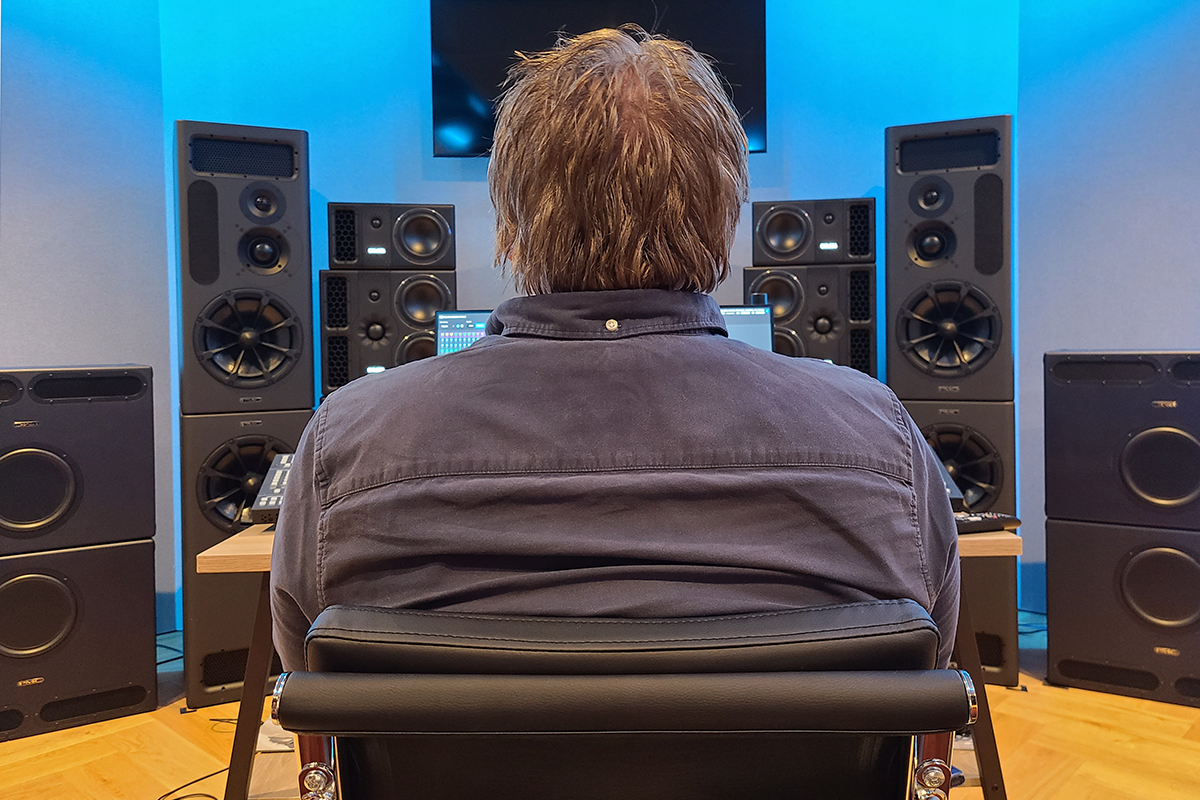Since the 1970s, record labels and audio manufacturers have been trying to convince music lovers to move beyond two-channel stereo. Music doesn’t just happen in front of us, argue proponents of surround music; it happens all around us. We could get a better experience if we added speakers beside and/or behind the listening position.
While home-theater fans have embraced surround sound for movies and TV, for music, most music fans have stuck with two-channel stereo. The quadraphonic vinyl formats launched during the 1970s bombed. The late 1990s saw the introduction of two competing optical formats, both capable of delivering 5.1-channel hi-rez music. DVD-Audio disappeared after a few years; SACD lingers on as a niche format.
Now surround music is back. In 2020, Amazon Music HD and Tidal began offering spatial audio tracks encoded with Dolby Atmos; Apple Music followed suit in 2021. Might the support of these streaming giants create enthusiasm for surround music among listeners?
There’s reason to believe it might. Dolby Atmos has some compelling features, including support for height channels, so that it can portray sounds from above, as well as sounds coming from in front, beside, and behind the listener. But what’s especially interesting about Atmos is its underlying architecture: it adds object-based placement to traditional channel-based audio.
A Dolby Atmos soundtrack can have up to 128 separate objects. These can be assigned to any of seven floor channels: front left, center, and right; left and right surround; and rear left and right. As with traditional channel-based formats, sounds can be mixed between the floor speakers (the “bed”) and panned about. But sounds can also be treated as objects—that is, the sound engineer can use a digital audio workstation to specify their positions in three-dimensional space, and move them about as desired. The position of each object at any given moment is stored as metadata. During playback, the Atmos processor uses this metadata to map objects to the specific physical speaker layout in the listening room.
For a November 2021 feature on Simplifi, “Dolby Atmos Music in Your Home,” Vince Hanada listened to spatial audio tracks from Tidal and Apple Music through his Atmos home-theater system, and came away impressed. While a 7.1.4 setup like Vince’s is the ideal way to enjoy Atmos music, you can also experience spatial audio through Atmos soundbars and car audio systems. Atmos tracks can also be rendered for playback through headphones; if done properly, this can create an immersive outside-the-head experience.
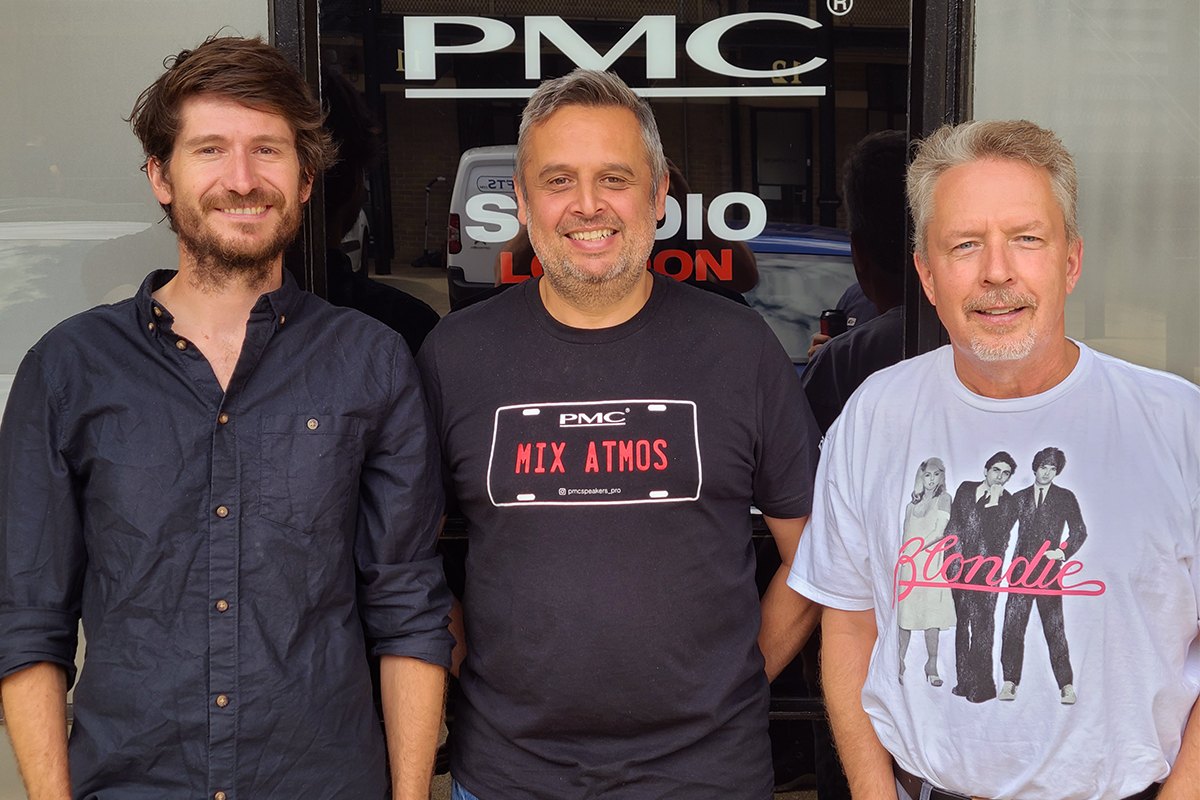 From left: PMC CTO Oliver Thomas, PMC brand ambassador Heff Moraes, and SoundStage! founder Doug Schneider
From left: PMC CTO Oliver Thomas, PMC brand ambassador Heff Moraes, and SoundStage! founder Doug Schneider
Last summer, SoundStage! Network founder and publisher Doug Schneider and SoundStage! Ultra contributor Jonathan Gorse visited UK-based Professional Monitor Company (PMC). During their visit, Doug and Jonathan were taken to PMC Studio London, one of three Dolby Atmos demo facilities operated by PMC. There, Heff Moraes, PMC’s UK brand ambassador, played several Atmos tracks, including songs by The Beatles, Elton John, Imagine Dragons, and Ariana Grande. Doug and Jonathan were both blown away. After the demo, Doug fired off an email to the SoundStage! editorial team: “We have to get on this Atmos thing more.”
Not long after, I sent an email to Moraes asking if he’d agree to an interview on what Dolby Atmos means for music. I wanted to talk about how musicians and producers are using the technology, and how eagerly it’s being accepted. Moraes seemed the perfect subject for such an interview. Before joining PMC in early 2021, Moraes had a long career as a recording and mix engineer. His credits include music by Cher, Bryan Ferry, Frankie Goes to Hollywood, Bruce Hornsby, Annie Lennox, Paul McCartney, Rush, Sade, and Simple Minds. Moraes graciously agreed to participate. The following interview, which took place via Zoom in late September, has been edited for brevity and clarity.
Gordon Brockhouse: Let’s start at the beginning. Tell me about your background and how you came to be working for PMC.
Heff Moraes: My first session was Band Aid’s “Do They Know It’s Christmas?” in 1984. The only reason I got to do this is because it was for charity, and no one else wanted to work for free. At that time, I was working in London at Sarm West Studios, which belonged to Trevor Horn and Jill Sinclair. Trevor was a very successful producer. He had produced acts like Yes, Grace Jones, Frankie Goes to Hollywood, and Seal. At Sarm, I worked a lot with Trevor and his partner-in-crime Stephen Lipson. Stephen and I went on to work with Simple Minds and Annie Lennox.
In 2017, I was asked to remodel a recording studio in a private member’s nightclub in central London called Tape London. At Tape, we have the biggest music artists in the world visiting on a regular basis. The idea was to completely blow these artists away with a sonic experience they would never forget. DJ Afrojack recommended PMC to us. Maurice Patist, president of PMC USA, put together an extraordinary system. The PMC QB1 XBD system should be too powerful for a room as small as the Tape studio, but the system has to be heard to be believed. What we set out to do we definitely achieved.
After that, I began using PMC monitors for mixing: a lot of hip-hop, and also for pop and singer-songwriter. The hip-hop stuff was being played in nightclubs, so getting the bass correct was extremely important, especially the relationship between the kick drum and bass. With their Advanced Transmission Line technology, PMC speakers have very accurate bass. The extraordinary thing about them is their lack of distortion—they’re extremely clear at low and high volumes. This is when my relationship with PMC really gelled.
Then, in April 2021, PMC mentioned to me that they had built an Atmos room in London and asked if I would like to get involved. Of course I would! They had started building the studio in October 2020 and it opened in February 2021.
GB: My colleagues Doug Schneider and Jonathan Gorse visited the London studio earlier this year. They were blown away by the Atmos mixes of “Rocket Man” and Abbey Road.
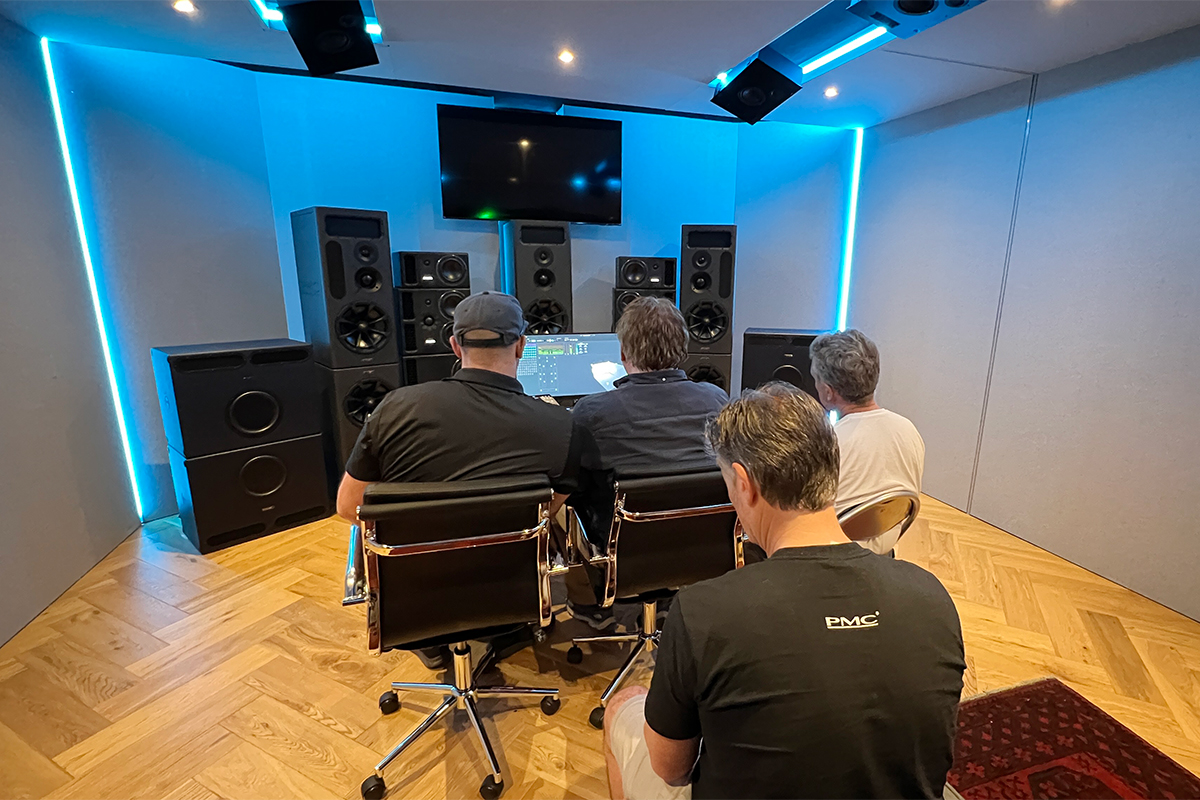 Atmos listening by the SoundStage! crew
Atmos listening by the SoundStage! crew
HM: I was there. When I played “Something,” by The Beatles, Jonathan was deeply moved. I’m a huge Beatles fan, and when you’re able to hear what Billy Preston is doing on the organ clearly isolated from the rest of the mix, and when you’re able to hear Paul’s bass in a completely different way because the mist is cleared and the bass is right there in the middle, it’s quite moving. This is music that’s indelibly etched on our hearts. For a Beatles fan, listening to Abbey Road or Sgt. Pepper in Atmos is like stepping into the album. No matter how many mushrooms you ate or how much weed you smoked, you couldn’t get that experience in stereo.
GB: PMC has other Atmos studios, doesn’t it?
HM: The first PMC Atmos studio was in Los Angeles, in a complex called LemonTree Studios. Now, there are many more Atmos rooms in the same complex. LemonTree was built as an 11.1.6 Atmos room to the same spec as Capitol B. Our Nashville studio opened around the same time as the London studio. There are plans to open more of these worldwide. PMC recently took on the services of a mix engineer from Capitol Studios, Nick Rives. He just completed a world tour—Europe, the UK, the Far East, and the UAE—delivering seminars on mixing in Atmos.
GB: Are PMC’s Atmos studios being used for recording projects, or are they demo facilities?
HM: We’re not a commercial studio and never want to be, because that would place us in competition with our clients. We want to foster the music industry’s relationship with Dolby Atmos, and help young, up-and-coming artists, producers, and mix engineers understand this exciting platform.
PMC has championed a couple of projects where we’ve mixed the entire album in Atmos, then held a launch at the London studio. One was an album by Swindle called The New World; another was an album by AJ Tracey called Flu Game. They’re both UK artists. Flu Game was mixed in LA and the artist came to the London studio to listen to it.
Trevor Horn came to the London studio to do an Atmos mix of the legendary first Seal album. There’s a band called Propaganda that was produced by my old friend Stephen Lipson, and we launched that at PMC Studio London. We don’t want to take work away from people. We just want to facilitate people’s understanding of Atmos.
Atmos is a fantastic platform, but it can be complicated to set up. There’s a big investment in speakers, hardware, and software; and the setup is complicated. If you get the phase or delays wrong, you can disturb the whole mix. But once you’ve got it right, it’s an amazing platform.
GB: Do you have a feel for the level of interest in spatial audio among listeners? Going back to the 1970s, we’ve seen surround music formats appear and then fizzle out. What’s different about this moment?
HM: What’s different is object-based mixing. That allows the mix engineer to think about space in a different way. With 5.1, it was basically the LCR array in the front, plus some reverb in the back. That wasn’t effective enough to make people want to put six speakers in their homes. With Atmos music, the mixes are much more immersive. There’s a lot more going on behind and above you.
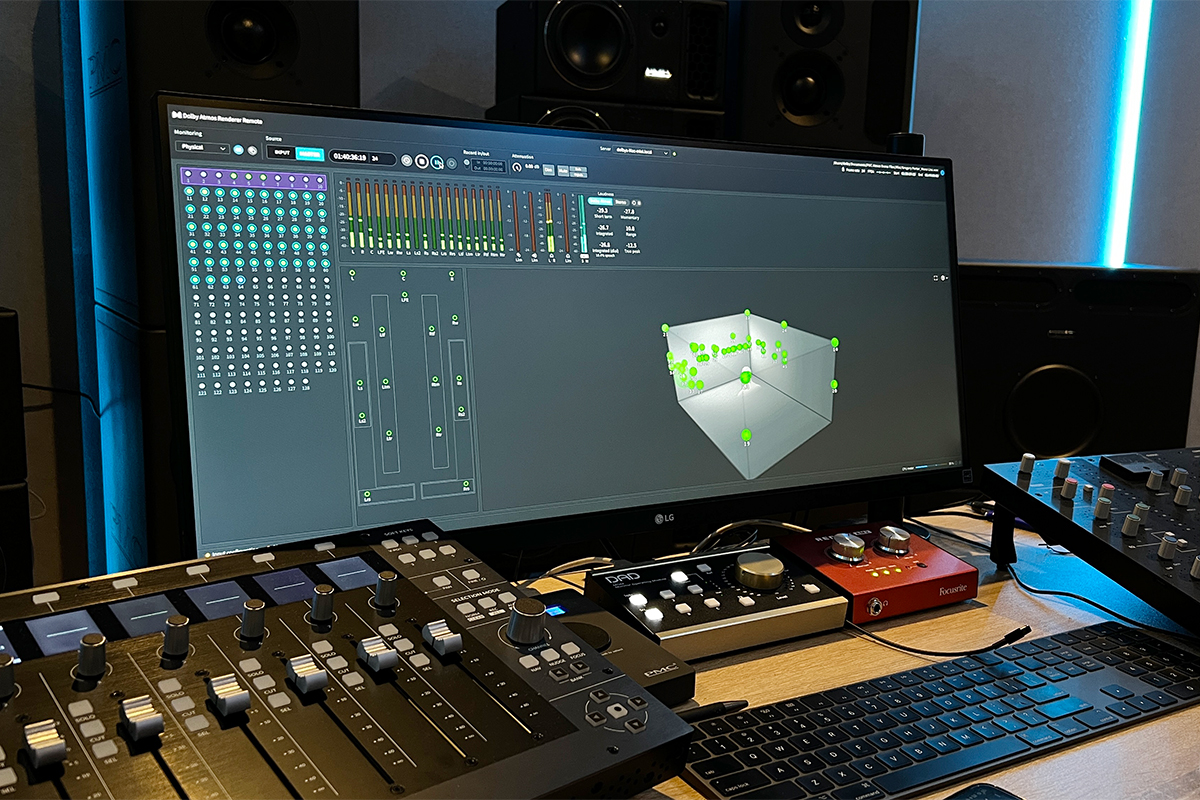
GB: Is there a big shift in mindset going from a channel-based to an object-based platform?
HM: Conceptually, it’s very different. There are lots of conversations about whether it’s best to work all in objects, or all in beds. I think any good Atmos mix needs a strong framework at the front: LCR. I use those as beds. I want that to be solid. But sometimes you want something halfway between speakers, and sometimes you want something in a specific place. That’s the wonderful thing about object-based placement—the sound is right over there. To a mix engineer, that’s a different experience.
Another thing I really like about Atmos is that it’s very difficult to dynamically limit objects. For the past 20 years, the industry has got into a terrible habit of limiting beyond recognition. It’s a silly game that goes on between the record companies and mix engineers about loudness. Because of the initial restrictions around limiting, Atmos mixes tend to have much greater dynamic range. Taking listeners on a dynamic journey disappeared from music. Dolby Atmos reintroduces it.
There’s a famous Atmos mix of Gregory Potter performing “Mona Lisa,” with him singing live with an orchestra. It has huge dynamic range. I’ve seen people moved to tears when hearing it. When it’s quiet, the listener is leaning in, trying to hear. In stereo, if something is quiet, people just lose interest. Atmos is completely immersive. Your senses are responding differently. You don’t mind the quiet bits because then you enjoy the loud bits.
GB: Back in 2016, I interviewed a sound engineer at a major Canadian TV network about an Atmos music project he had worked on. He told me one of the things he appreciates about Atmos is “spatial unmasking.” Two instruments, close in frequency and dynamics, that in stereo would be mushed-together, can be separated spatially in Atmos so that it’s easier to hear them.
HM: That is one of the many wonderful things about mixing in Atmos. Atmos allows you to separate sounds in a completely different way. Instead of using EQ, you can use space. The challenge is that at some point, for headphone listening, the mix is going to fold down to binaural. You constantly need to be checking that.
Right now, 80% of the people consuming music consume it on headphones. My kids don’t listen to music on a stereo system—they have no interest in that. They don’t listen through a soundbar because they don’t watch TV. In the studio, we have a setup that lets us hear the binaural downfold on headphones, so I can hear how Apple and Tidal will translate a Dolby Atmos file into spatial audio for headphone listeners.
The challenge with headphones is that we all have very different ears and we all perceive space differently. So, obviously, what Dolby has had to do is create an average. I don’t get an extraordinary experience hearing a binaural downfold through headphones, whereas people I work with do. As the technology improves, the binaural experience will improve for everyone.
GB: That’s interesting, because I’ve had amazing experiences dating back to binaural demonstrations by Stax during the 1970s and ’80s.
HM: It doesn’t work the same way for me because my ears are shaped differently than yours. But there is a lot of technology being developed so that headphones can adapt to individual ear shapes.
GB: So the goal is to filter the sound specifically for the shape of your head and ears, so that it matches the way you perceive direction?
HM: Exactly.
GB: Isn’t Apple doing that now? With the latest version of iOS, you can use your iPhone to scan the shape of your head and ears, and the app will create a personalized HRTF (head-related transfer function) that works with Apple AirPods.
HM: I haven’t heard it yet, but that’s what we’re moving towards. Once they get that to work, and once they make it simple, spatial audio will make huge leaps. That’s the key that will unlock everything.
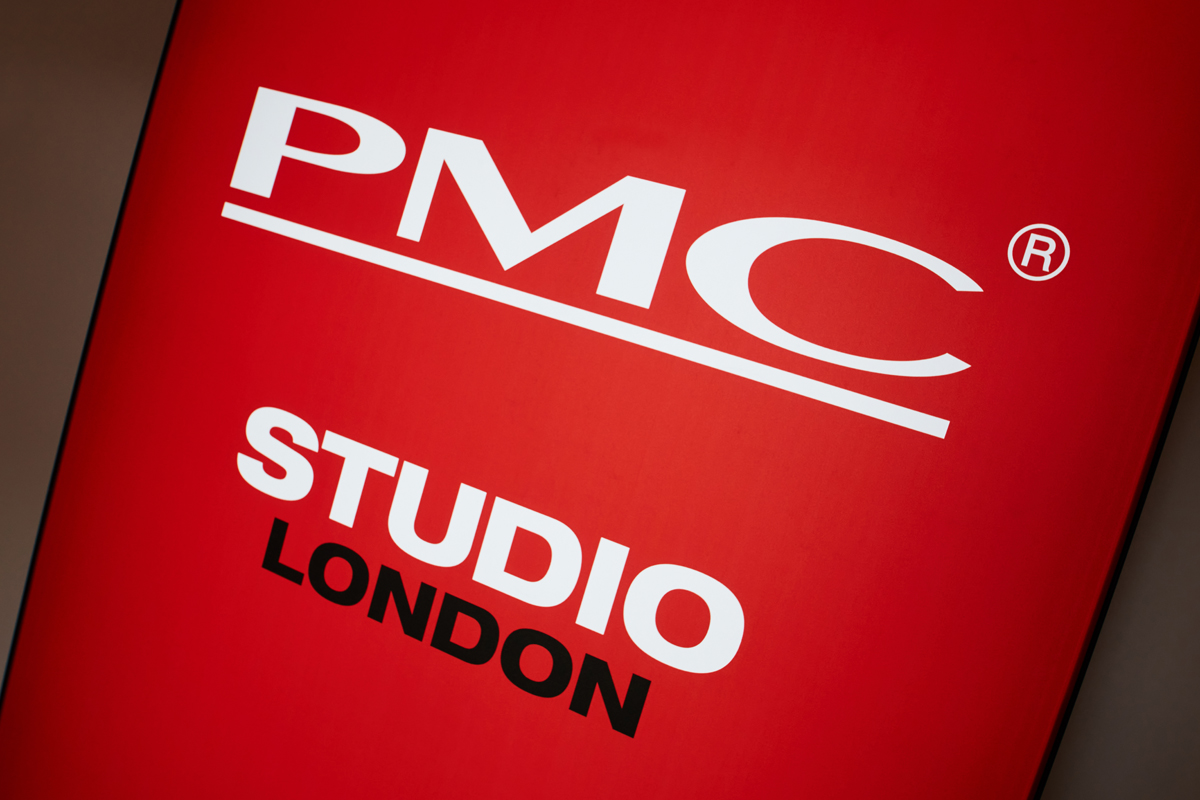
GB: What sort of interest are you seeing among creators in spatial audio? Is it a minority interest? Do they view it as important?
HM: It’s a vast majority interest. There seems to be a big divide between the UK and the US. In the UK, there is always a bit of suspicion about new things. Everyone’s interested in Atmos, but they want to know more about it. In the US, people aren’t suspicious; they see it as an opportunity. I was recently in America to attend the NAMM [National Association of Music Merchants] Show in LA. I met several mix engineers whose careers have been transformed by Atmos.
Artists tend to be a little suspicious if someone’s going to change something, particularly if they’re not involved. I’ve had artists come into our London studio and be blown away. They say: “For my next album, I’m going to go to an Atmos room so I can write my music with Atmos in mind from the very inception.” And I’ve had some people say: “I’m not sure about this. It’s going to change my mix.” There are all sorts of forums online talking about the challenges of binaural. Once you talk them through the challenges, most creators jump on, because there’s huge opportunity here.
GB: At the outset of a project, do creators go in with a particular aesthetic in mind? A way they want to exploit the technology?
HM: Of course. With Atmos, you’re creating a space where you’re placing the listener. There are some great Dolby Atmos mixes where there’s a lot of stuff moving around the room. A great example is “Believer,” by Imagine Dragons. Some of the things the mix engineer does with the vocal track are genius. In the last verse, he collapses the vocal down to the center speaker in mono, and then snaps from that into full Atmos. You get fooled into thinking that mono image is your sonic space and then it suddenly explodes.
But some tracks don’t warrant any movement. The Gregory Porter version of “Mona Lisa” has no movement. What that track is doing is placing you in an immersive space in the middle of the orchestra.
GB: With the hall behind you?
HM: No. You’re standing where the conductor would be, with the orchestra wrapping around you, plus a little bit of creative license.
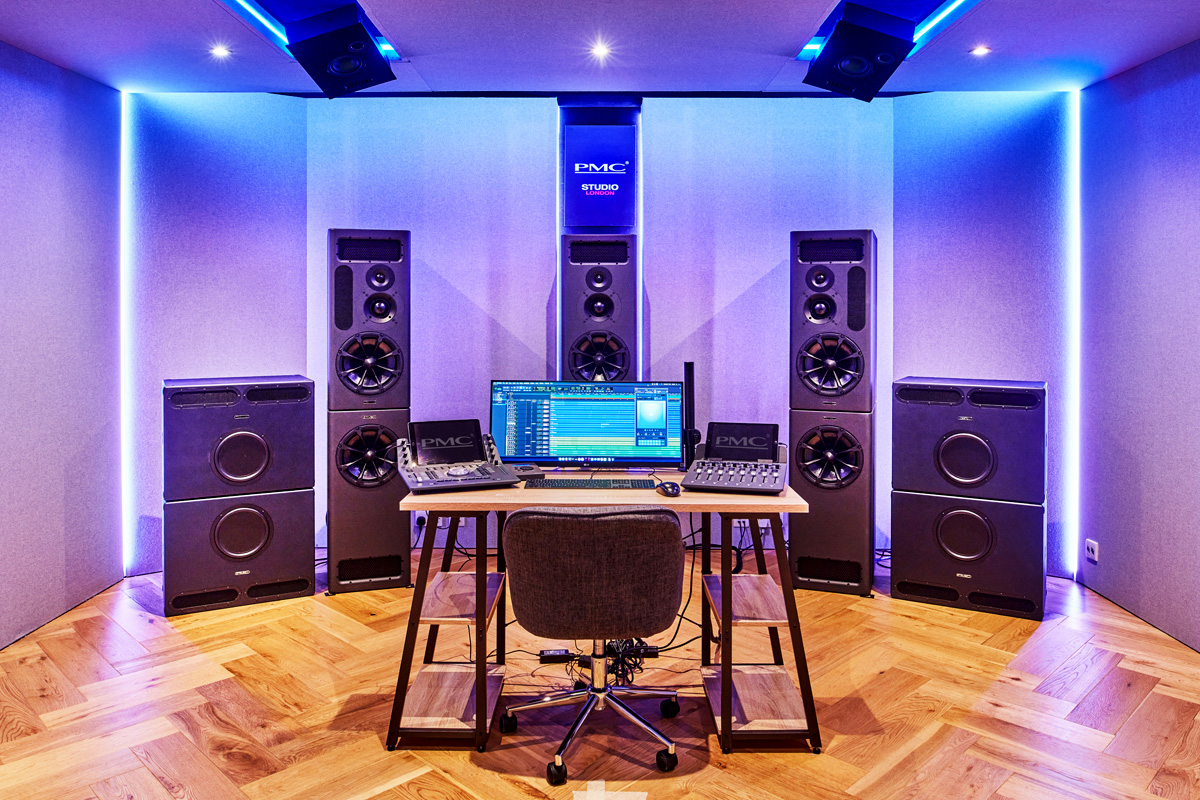 Inside PMC Studio London
Inside PMC Studio London
GB: Give me a few other examples of great Atmos music tracks.
HM: I love a lot of the work Giles Martin has done on the Beatles stuff. There’s a mix by Jon Castelli of a track by Disclosure featuring Khalid, called “Talk.” It’s extraordinary. I discussed how you could have stuff moving around depending on the content, or you could have stuff static. This mix hits it right in the middle. It’s very tasteful—not gimmicky at all. Strangely, the stereo mix sounds over-mastered to me because the bass distorts a bit. The Atmos mix doesn’t have any of that. It’s just pure.
GB: We’re seeing Atmos versions of music that’s traditionally performed right in front of you. Deutsche Grammophon is releasing orchestral and solo piano music in Atmos. Does Atmos make a contribution to music that’s all in front of the listener, with the hall behind?
HM: Of course, it does. The hall isn’t just behind you—it’s beside and above you. My preference is to juice that experience a little so that it’s not just the hall behind you. That’s a little like 5.1, so the experience is not as immersive as it could be. There are tricks you can use to give the impression that’s what you’re doing—but you’re doing a lot more. There’s some instrumentation behind you. Atmos lets you be much braver than you can be in 5.1.
GB: When mix engineers are working on these projects, what are they thinking about the target playback system? It can’t just be an 11.1.6 system like the one in PMC’s London studio. Are they thinking headphones or Atmos soundbars?
HM: There will be some people who listen in a proper Atmos room.
GB: Yes, there are lots of people with home theaters. . . .
HM: And there are Atmos cinemas. There’s a cinema in London where on some nights they close the curtains and play Sgt. Pepper in Atmos. Working in an 11.1.6 room, you also have to be thinking it might be upscaled to a system with hundreds of speakers. You also have to consider soundbars and headphones, because that’s how most people will be experiencing the content.
There’s a lot going on with Atmos soundbars—the Sennheiser Ambeo is a good example. Sonos has some good Atmos soundbars. These are easy to install. You don’t have to string wires all around the room, which was a problem with 5.1 in the past.
All the major car manufacturers are jumping on board. I’ve heard Atmos in a Tesla and a Volvo. Both experiences were extraordinary.
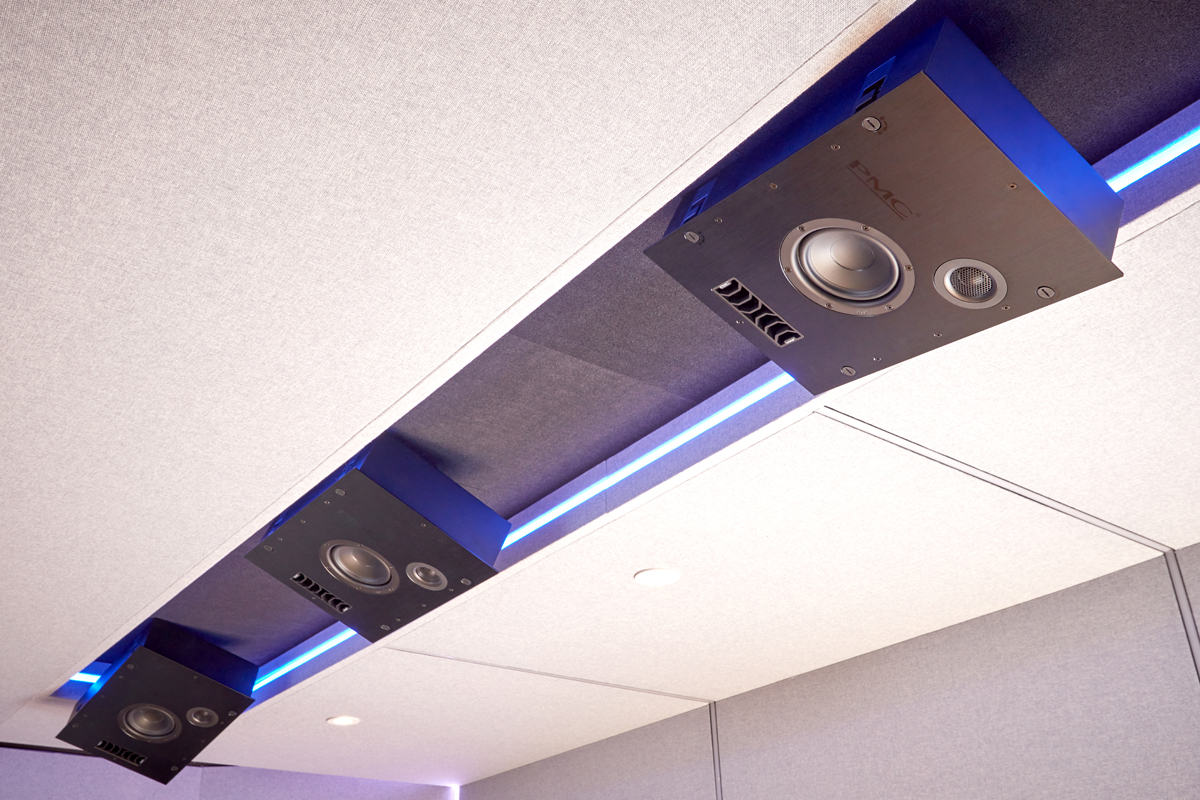 Some of the height speakers at PMC Studio London
Some of the height speakers at PMC Studio London
GB: In the Tesla and Volvo, do you recall how many speakers they were using? Were there height speakers in the top of the cabin, or were they upfiring from below?
HM: In both cars, the height speakers were above ear level. I’m pretty sure that both were 7.1.4 systems. I sat in all the seats. Obviously, the front was better, but even in the rear seats, it was a great experience.
GB: As interest in spatial audio grows, do you expect there to be two parallel workflows in mixing studios: one for Atmos, and another for two-channel?
HM: It’s interesting you ask that. I mix in stereo, and when I’m completely happy with the result, I mix in Atmos. Frankly, that’s not very efficient. If someone wants to make a change on the stereo and the Atmos mixes, that’s a right pain in the backside—I have to redo the work twice.
I recently met some young engineers who are mixing in Atmos while consistently monitoring the stereo downfold—even if the client hasn’t asked for an Atmos mix. Then they send the client the stereo downfold and say if you want us to do an Atmos mix we can, but it will cost extra. But they’ve already done the Atmos mix. That’s much more efficient.
GB: Can you deliver as good a product with a two-channel downfold of an Atmos mix compared to a dedicated two-channel mix?
HM: I’m not sure I can, but it can definitely be done, because I’ve seen these guys do it.
GB: Apple and Tidal both use Dolby Digital Plus, which employs lossy compression, to distribute spatial audio. How much of a compromise is that?
HM: If I listen on my system at home, I can hear the compression. But if I listen on AirPods or plug-in headphones, it’s harder to hear the difference. That’s how most people are listening. And most people aren’t listening as analytically as I am. Of course, it is a compromise, but I’m not sure it’s a compromise that matters to the consumer.
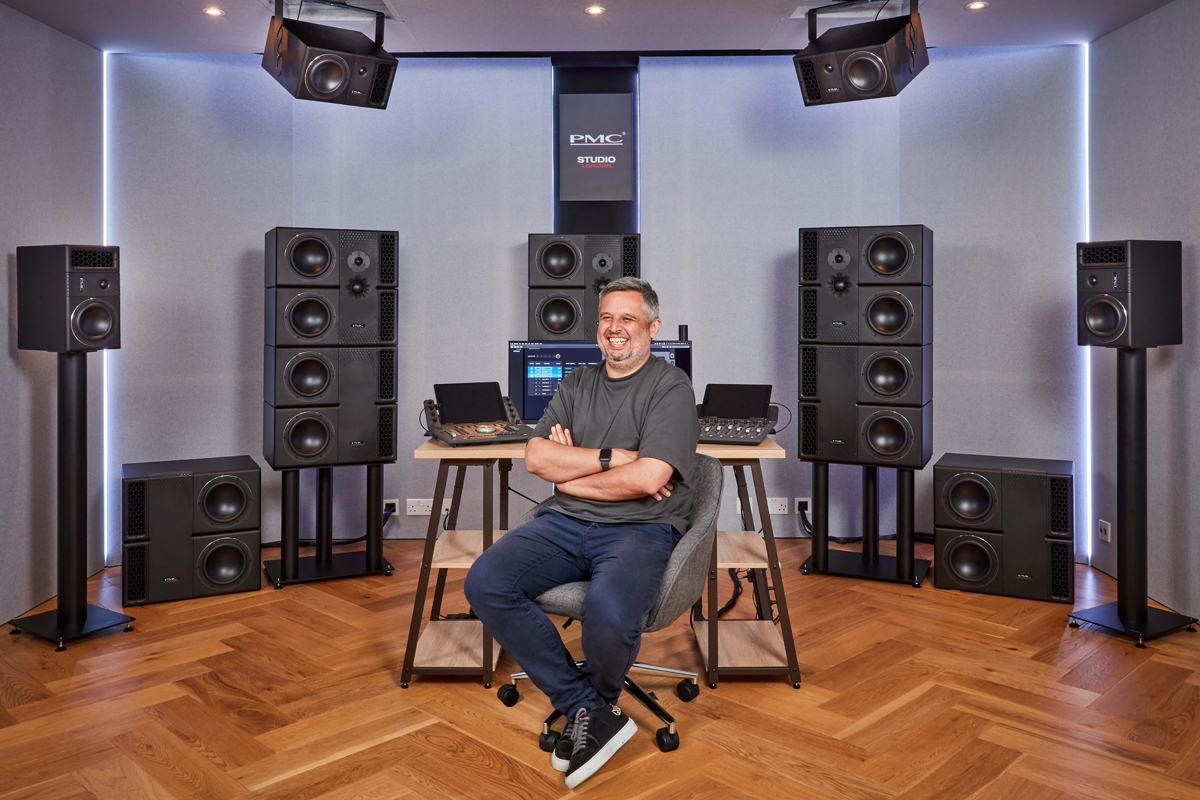
GB: You said 80% of music is being consumed on headphones. Do you see that changing? Will people who are listening through headphones at one stage in their lives want a speaker-based system at another stage?
HM: That’s a difficult question for me to answer because I love listening to speakers. However, if my kids were here, they’d ask me: “Why do you want to listen to music on speakers? It’s better on headphones because it’s right there.”
There’s a bigger question, which is their generation’s hearing. I’ve never asked my kids about that, but I’m hoping at some point their bodies will say: “That’s enough. Now I need some space.” Hopefully, as people get older, they want to be more sociable. You can’t be sociable and listen to music on headphones. Obviously, speakers will be around for a very long time because that’s the only way for more than one person to listen to music at the same time. Experiencing music together is important.
. . . Gordon Brockhouse



